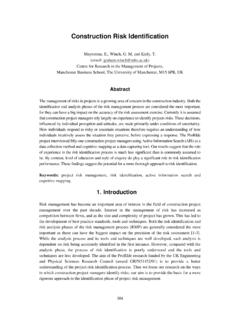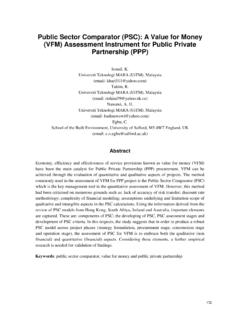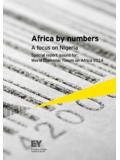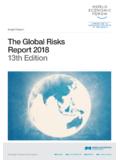Transcription of Stakeholder Engagement in Managing Risk - …
1 Stakeholder Engagement in Managing Risk Loosemore, M. Faculty of the Built Environment, University of New South Wales, Australia (email: Phua, School of Construction Management and Engineering, University of Reading, UK (email: Abstract In the increasingly emotional and regulated business environment, effective risk and opportunity management has become a basic necessity for every organization, as has the ability to communicate effectively with external stakeholders about risk. The potential costs of poor communication with stakeholders during this process are enormous but the potential benefits of effective consultation are even greater.))
2 Drawing on research in Stakeholder management and multimedia this paper presents an in-depth case study of how multimedia technology was used to help a government health department develop a risk and opportunity management strategy to respond to climate change risk to its infrastructure. This research has revealed the practical advantages of using multimedia to engage stakeholders in the risk and opportunity management process. Future research needs to explore the pedagogical advantages of multimedia in helping organizations develop a risk and opportunity management culture.
3 Keywords: risk, opportunity, communication, stakeholders, perceptions 1711. Introduction The recent global financial crisis has vividly demonstrated that businesses, institutions and markets are connected in ways which are not fully understood (WEF 2009). This is requiring a paradigm shift from narrow and traditional conceptualizations of risk management which historically have excluded stakeholders to a more inclusive notion of Stakeholder Engagement in Managing risk and opportunity (Barnes 2001). In the future, the implicit question facing any organization will be not just whether it is Managing its risks effectively but also whether it is communicating this effectively to its stakeholders.
4 This paper is a response to this challenge. Its aim is to discuss the role of stakeholders in the risk management process and the potential role of multimedia technology as a means to better facilitate this. 2. Risk management from a Stakeholder perspective Stakeholder management theory conceives an organization as a complex, dynamic and interdependent network of multidimensional relationships with a wide variety of stakeholders. Performance and competiveness depend on how well firms manage and nurture these relationships strategically in order to achieve corporate objectives and how they are perceived to manage them by the stakeholders, in their interests (Zsolnai 2006).
5 From a risk management perspective the benefits of consulting with these stakeholders are said to be numerous and include: higher levels of trust with Stakeholder groups; stakeholders being able to contribute to decisions affecting their future; higher quality information for making business decisions; a wider understanding in the community of constraints upon firms; stakeholders feeling more involved in decision-making processes and feeling their interests are being considered; stakeholders better understanding their risk and opportunity management responsibilities and; greater collective responsibility in Managing risks .
6 In essence, the Stakeholder paradigm is based on the premise that people are not rational when thinking about risk but are influenced by cultural and social networks in which they are imbedded. In other words, people form their own subjective perceptions of risk which often differ from the objective assessments made by managers, experts and scientists and their behaviour reflects these perceptions (Berry 2004). Ultimately, it is argued that there is no other way for managers to interpret risks other than in terms of human values, emotions and networks.
7 This position is supported by Barnes (2002) who points out that while risk managers have become more scientifically and technologically sophisticated in their approach to Managing and measuring risk, the majority of the public continue to rely on cultural and social explanations of risk events, leading to significant perceptual differences between the community and the private business sector. Therefore, it is likely that in many companies there may remain significant institutional blind spots which ignore the contextual experience of risk and the perceptual issues that are relevant to public concern (Loosemore et al 2005).
8 1723. The power of multimedia in Managing risk and opportunity Multimedia technology can offer a potential solution to Stakeholder Engagement in the risk management process. Multimedia is a combination of two or more communication mediums such as text, image, sound, speech, video, and computer programs. From a risk management perspective, the main advantage of multimedia compared to traditional mediums of communication is its ability to engage, enthuse and stimulate the stakeholders involved in the learning process which occurs when Stakeholder knowledge is effectively integrated (Nonaka 1994).
9 For example, Wright (2004) studied operative and management training in a range of major organisations and found that multimedia offered numerous pedagogical advantages over traditional training methods. Indeed, research indicates that people, no matter what background, retain and understand up to 91% more when using multimedia compared to computer and paper-based management systems (Bailey 2001). While multimedia is used in industries like mining and power transmission to manage risk (Wu and Che 2008) it is used little in construction and even less in a more general corporate enterprise-wide risk management context.
10 Loosemore et al (2005) argue that most approaches to risk management in construction are unimaginative, pedagogically un-stimulating and appear deliberately designed to exclude rather than involve people in the risk management process. 4. Method To explore the apparent potential of multimedia to involve stakeholders in risk management, this section presents a case study of an organisation that used a new multimedia approach to risk management called ROMS (ROMS 2009) which is currently being used by Australian and New Zealand Health authorities to develop a national adaptation strategy to enable hospitals to cope with the health impacts of climate change (Carthey et al 2008).














